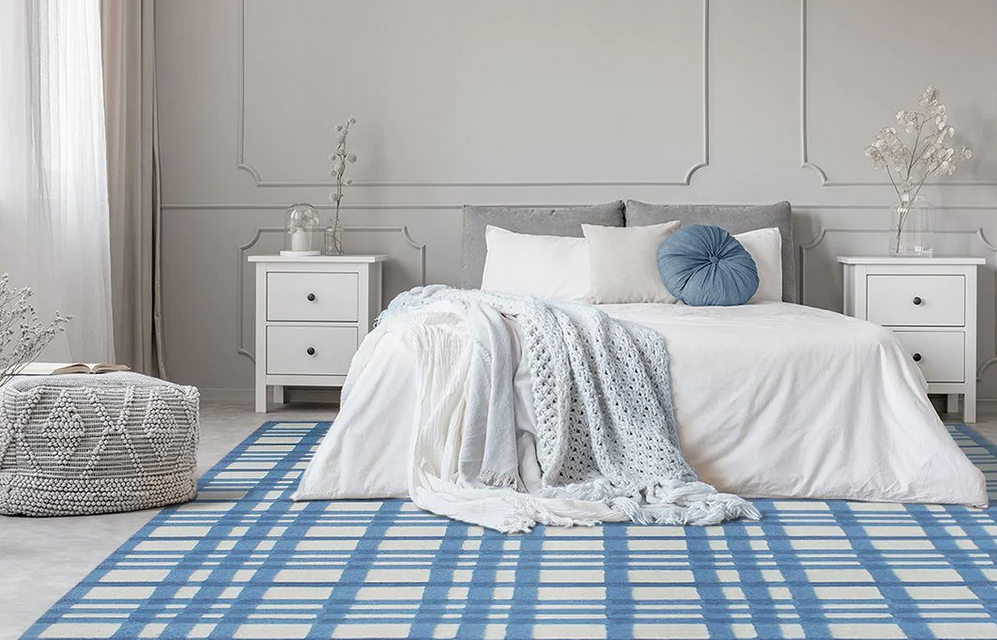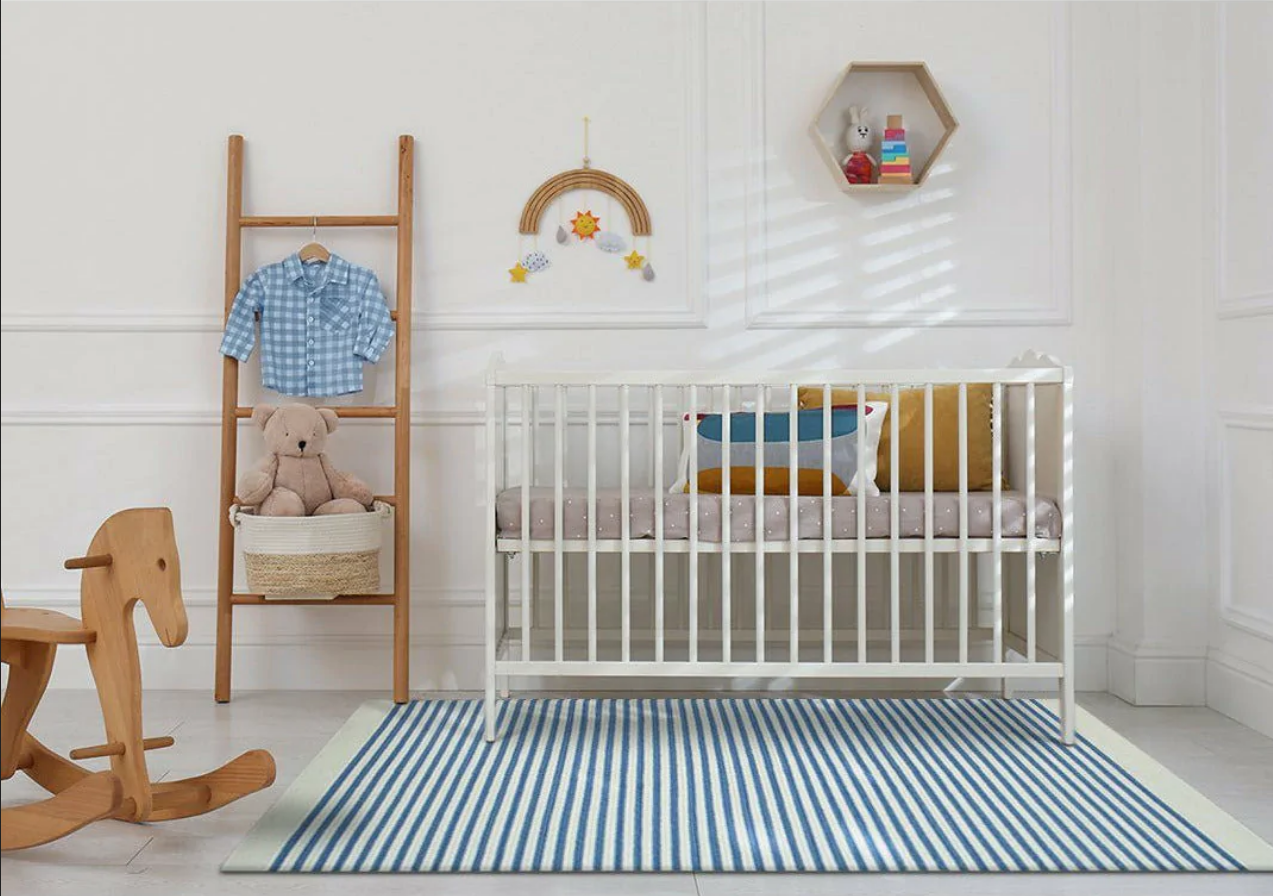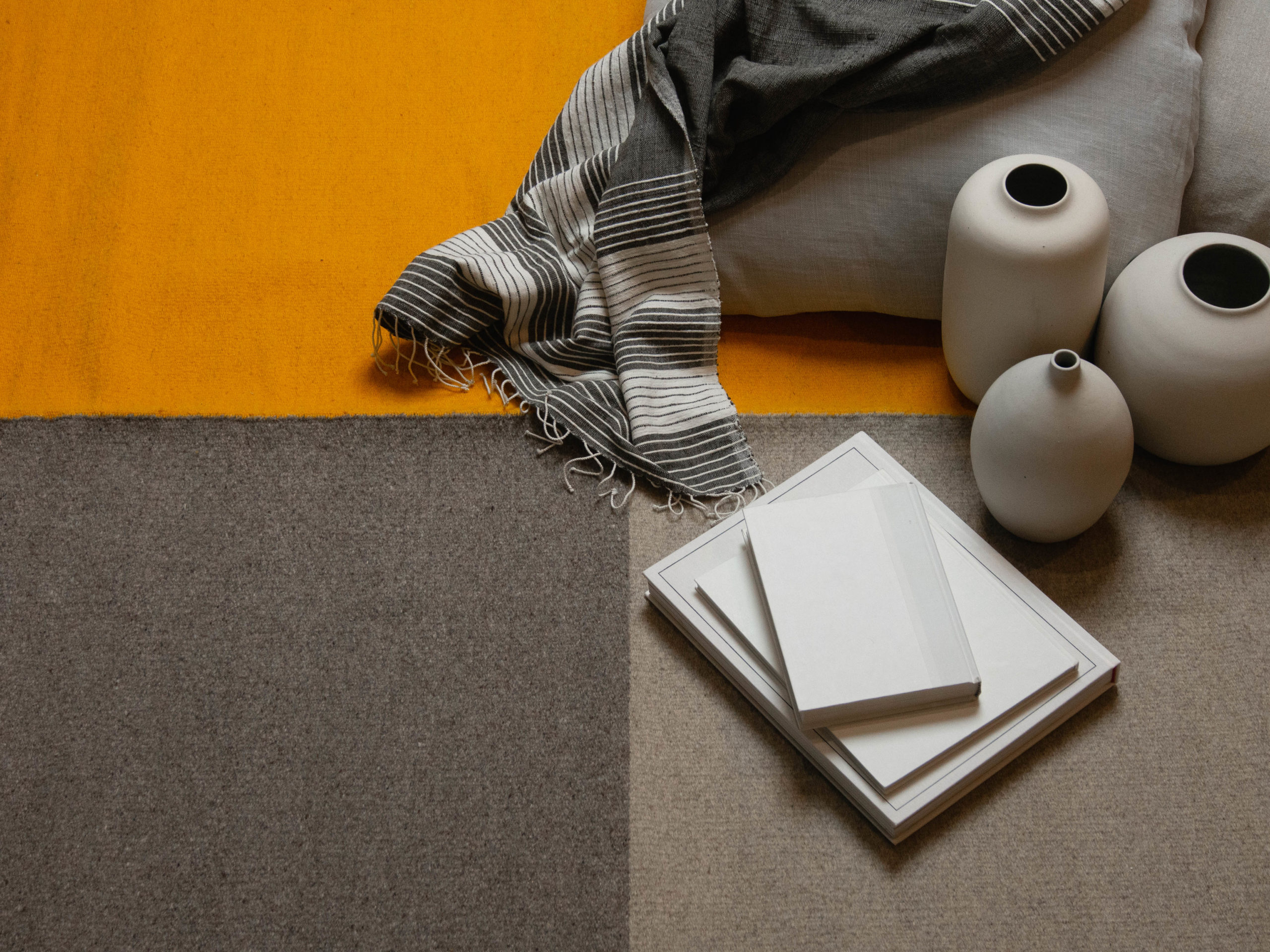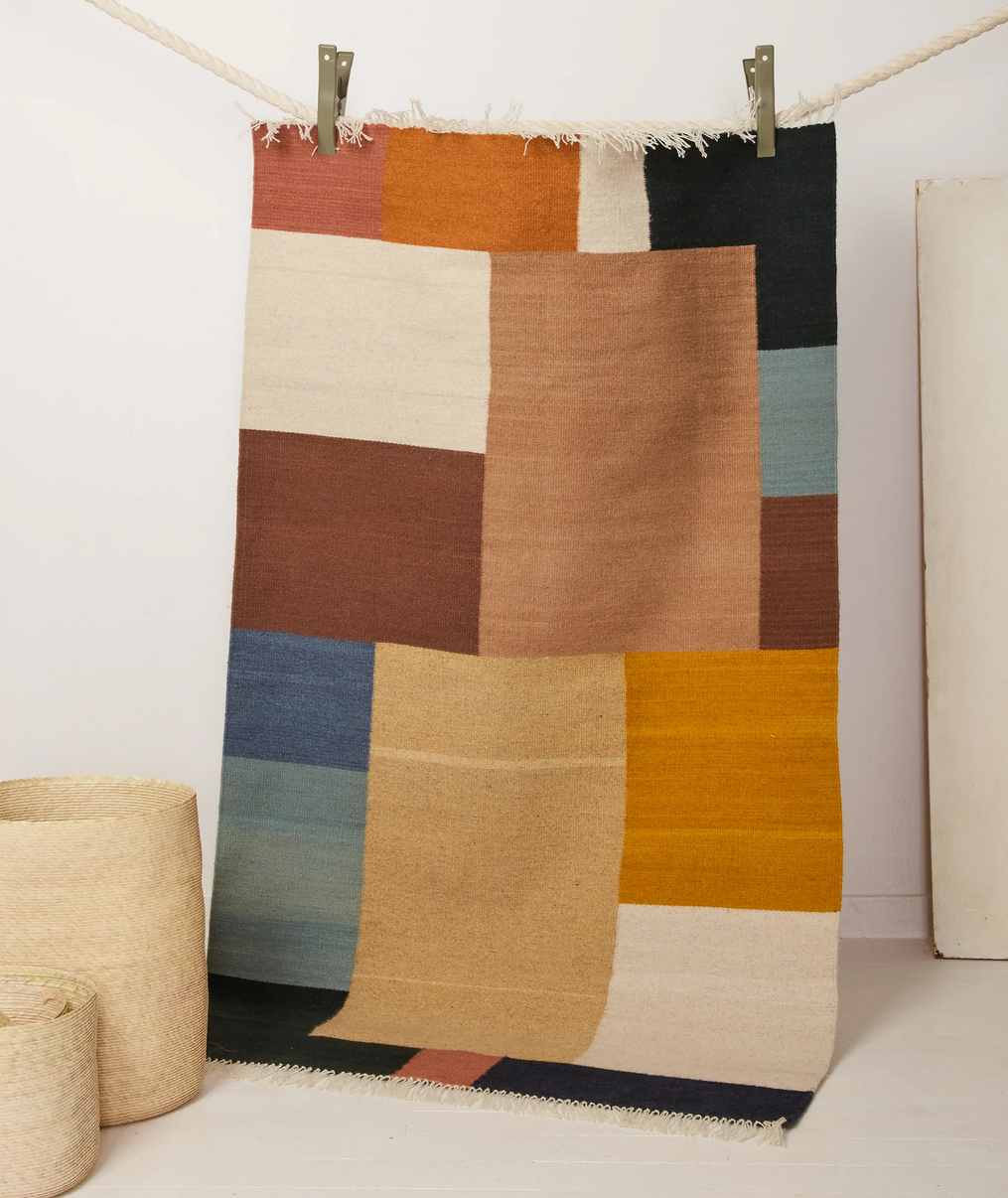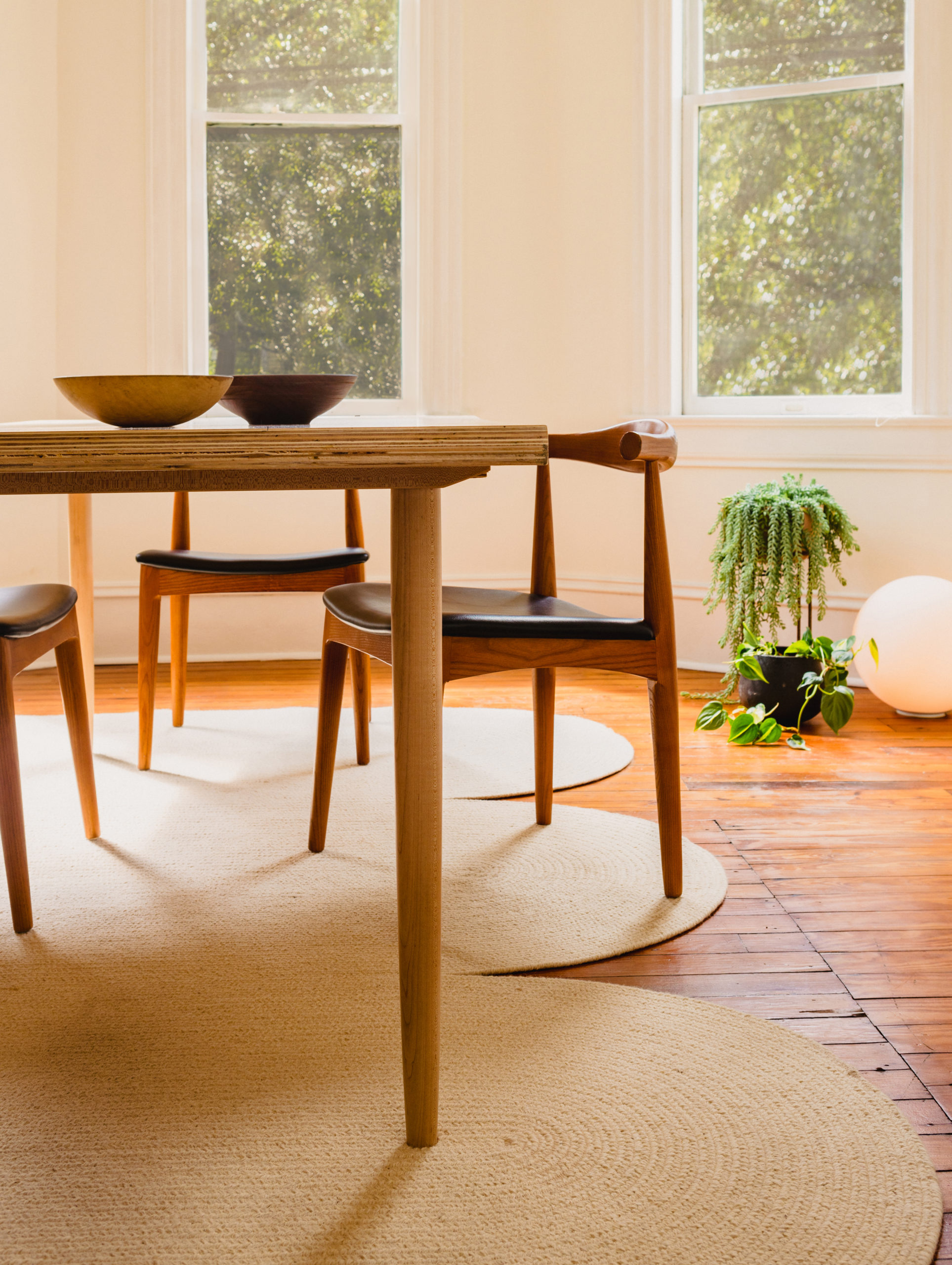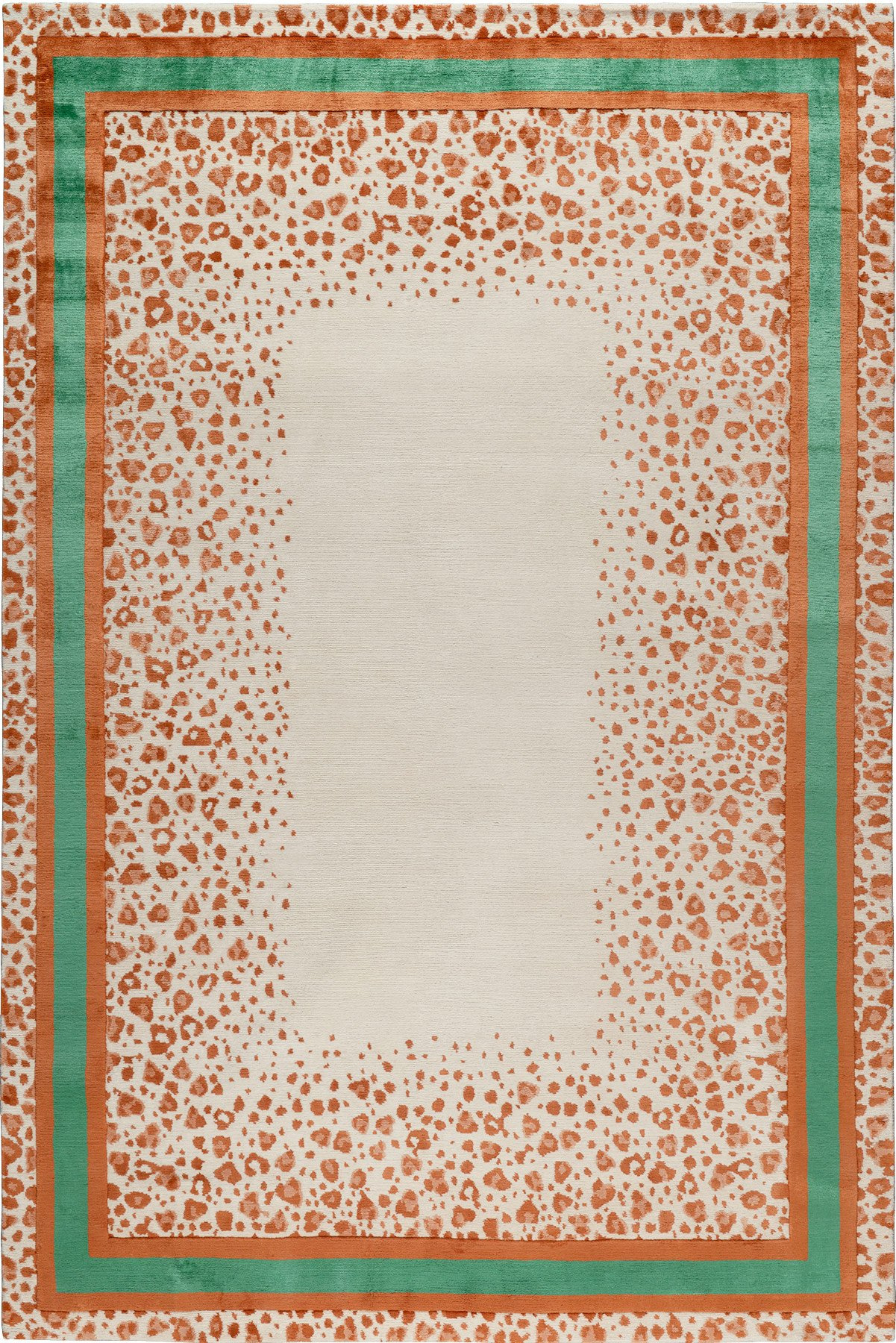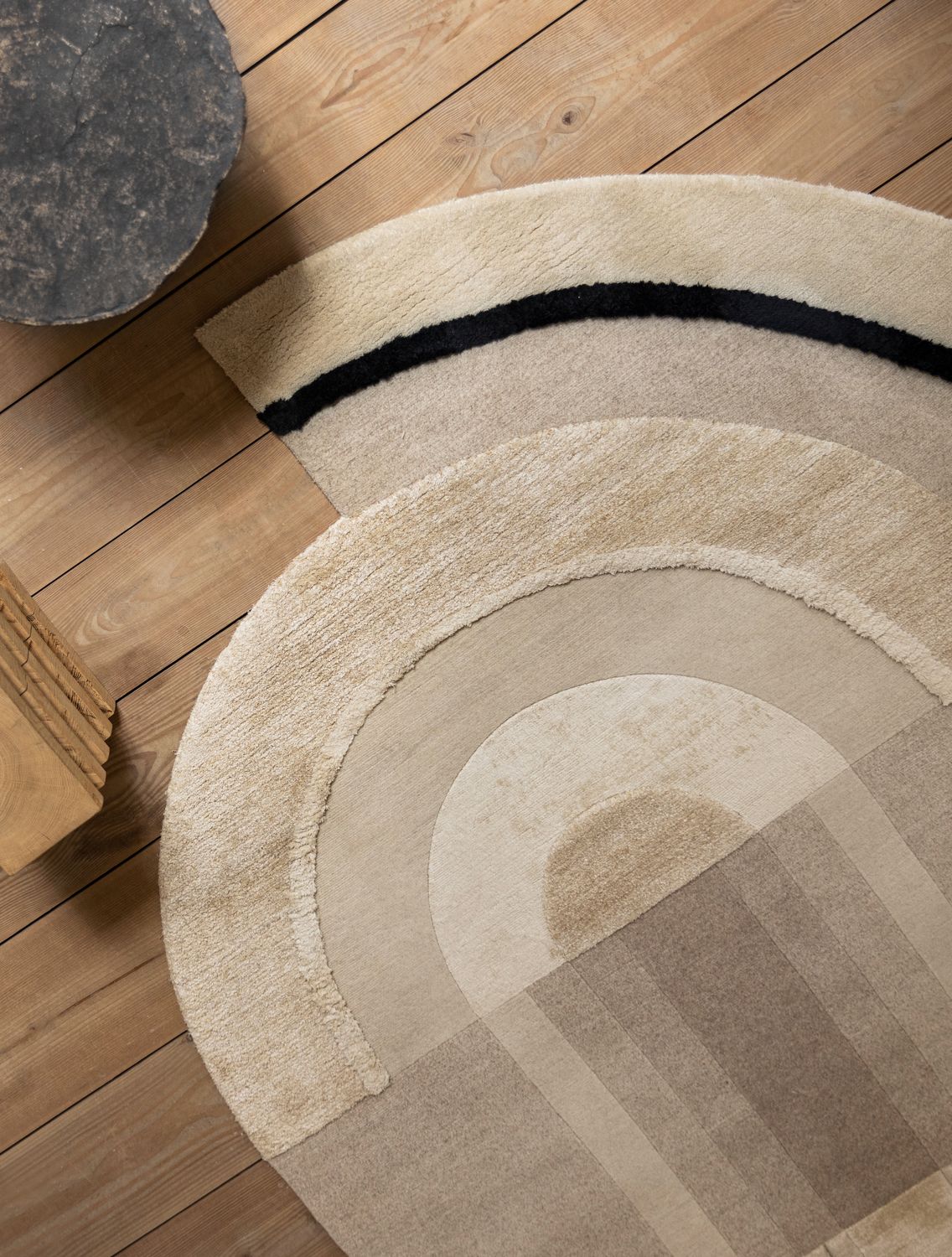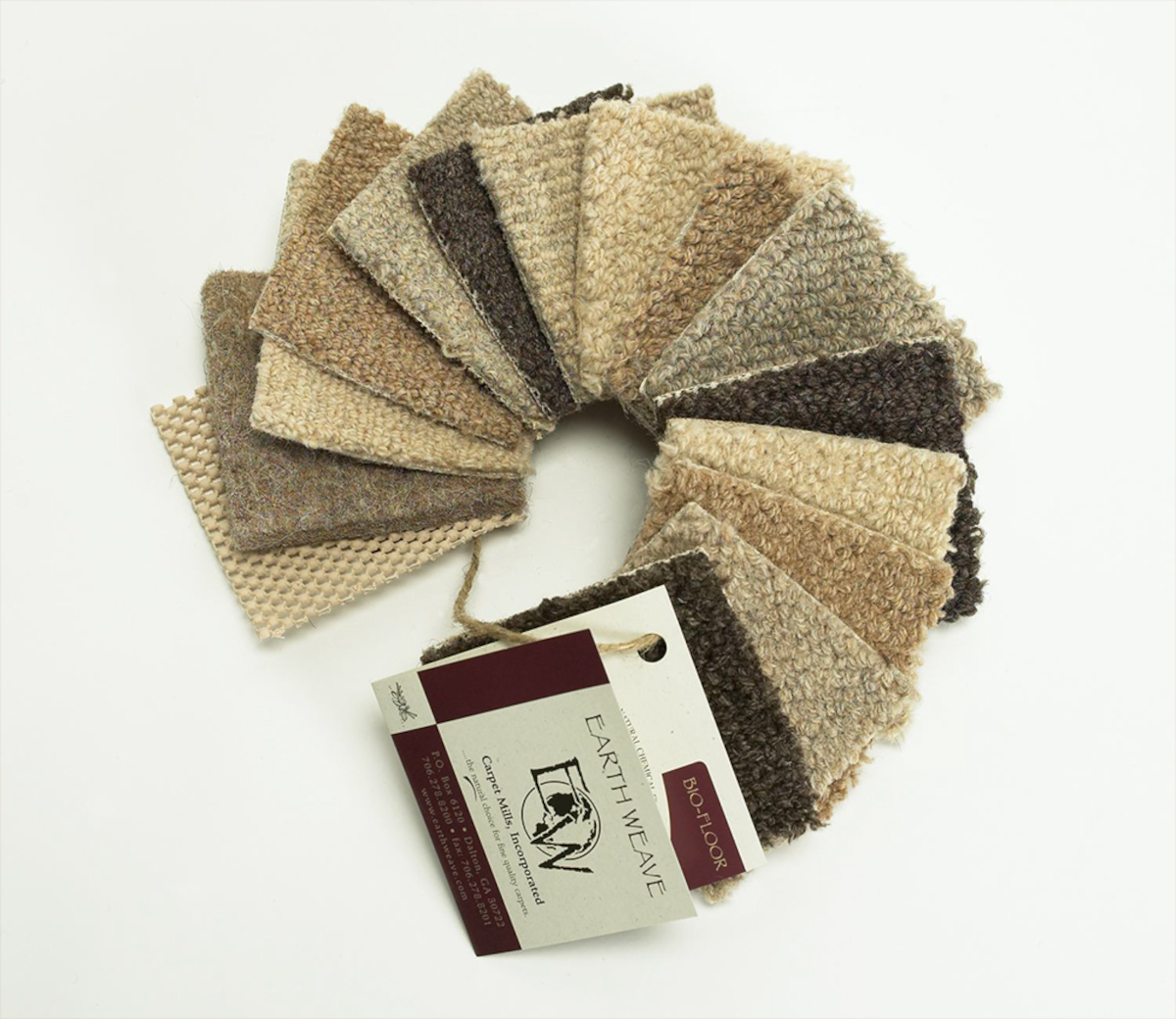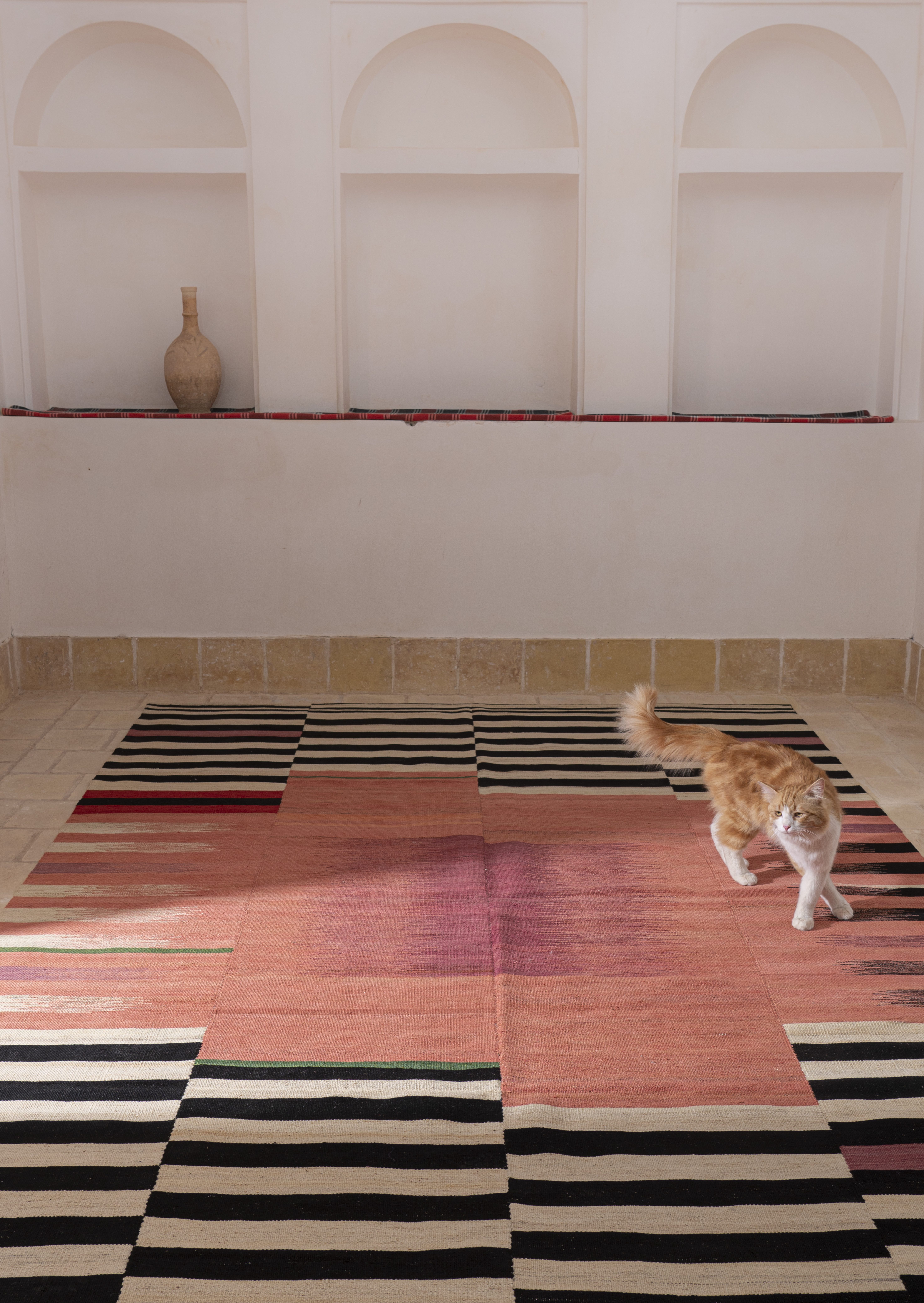Photo Courtesy Organic Weave
Non-toxic area rugs for your room, your family, and the environment
An area rug evokes feelings; it adds physical and emotional warmth. But even more important, it affects the air quality inside our homes. We spend so much of our time indoors that indoor air quality (IAQ) can impact our health. And pets and children often get up close and personal with your choice of an area rug.
Begin with organic
Organic Weave addresses this fundamental topic of IAQ: “When we walk on rugs or sit on furniture, the abrasion causes small particles to enter the air. If there are harmful chemicals in our home furnishings, those chemicals enter the air and create a dust debris. We can inhale, ingest and absorb toxic chemicals.”
Choosing organic materials means non-toxic rugs that you don’t have to worry about off-gassing. Organic farming is better for farmers, for animals, and for the broader environment. And finally, where area rugs are handcrafted by artisans, organic manufacturing protects them and their families from exposure to harmful chemicals.
So what should you look for when shopping for eco-friendly, non-toxic rugs? It can be confusing. If you think that non-synthetics like cotton qualify, you’re only partially right. Much like fruits and vegetables, it depends on how the crop was grown, whether it was treated with pesticides or fungicides, and how it was harvested. If wool is dyed, is it with chemicals or natural products?
Viscose, a wood-based material, is a fiber that, like silk, when combined with wool gives luster or sheen. Safe, right? While the source is from nature, the production process can be highly polluting. And the materials may be treated with chemicals before they are spun into yarn or thread. Those chemicals become airborne at the factory and enter waterways surrounding production plants.

Shop your values
Ultimately, the most important factor in choosing an area rug is sourcing. Brands that are transparent will detail the origin of their product, from farm to spool to weaving to your home
A bonus for the majority of earth-friendly, non-toxic rugs is artisanal weaving. Some rugs are loomed in the US. Others have a global reach: India, Nepal, Iran, South America, and Mexico. Often, the makers come from generations of weavers thrilled to carry on family traditions. While some eco-friendly rugs may be immediately available, there often is a lead time of two to six months. The upside to pre-ordering is that some allow customization of colors and sizes, for a truly bespoke product.
Social responsibility goes hand in glove with sustainability in the supply chain. That means ethical production. Fair Trade means no child labor, a living wage, a safe working environment. Some brands are invested in their communities, as well.
A word about cost: Organic products often get a bad rap because of assumed higher price tags. In the case of eco-friendly, non-toxic rugs, there’s quite a range in price. Compared to non-organic counterparts, many eco-friendly area rugs are surprisingly affordable, available for hundreds of dollars. An average price for a 6 by 9 foot eco-friendly area rug is about $1,500. And even at the higher end, there’s no substantial difference.
What to look for
Here are some materials and disclaimers to look for in eco-friendly and nontoxic rugs:
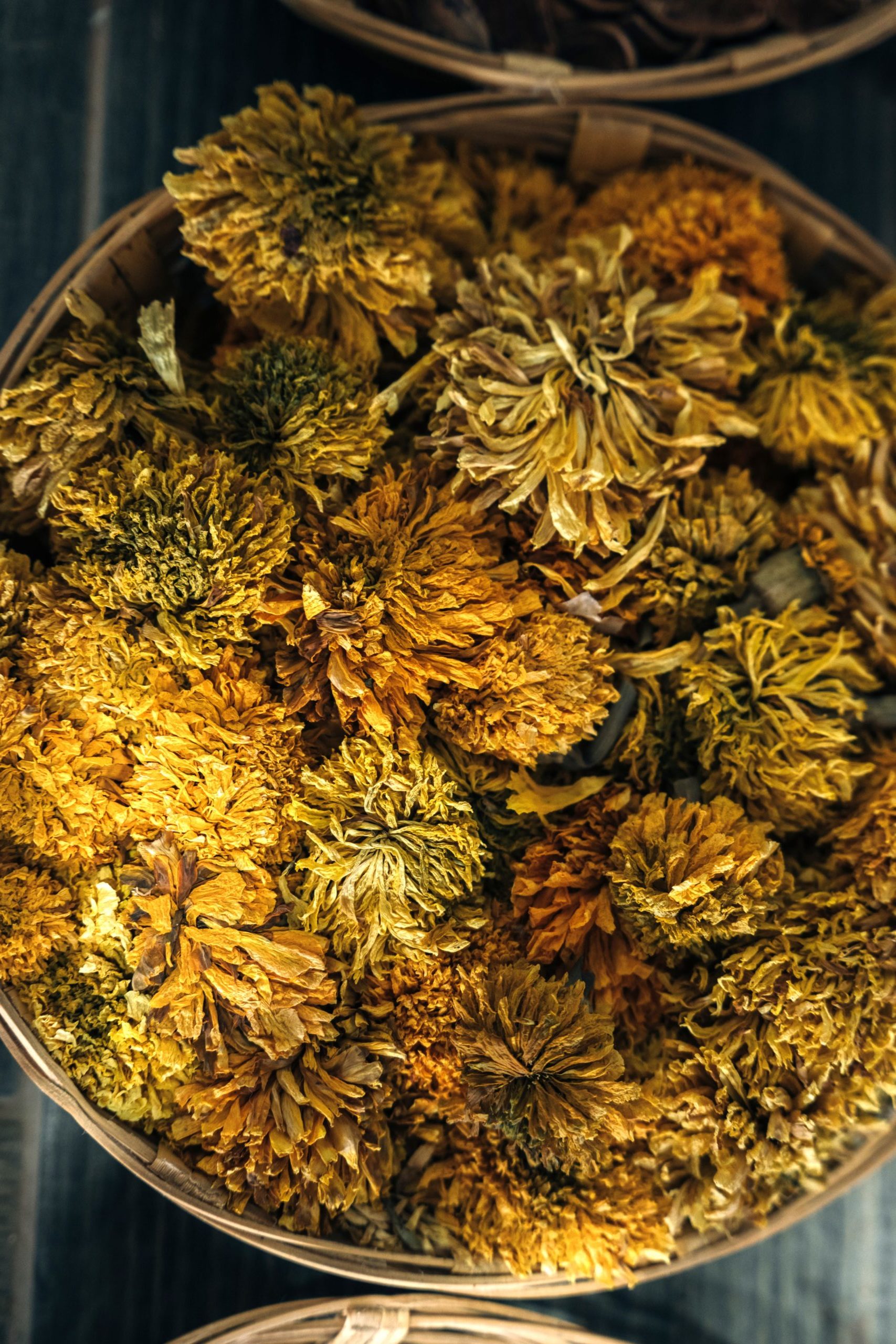
Image courtesy Obakki
- Natural raw materials. These include wool, jute, hemp, bamboo, silk, sisal, palm fibers, and organic cotton.
- Recycled materials. Using textile waste is not only resourceful but sustainable. For example, some rugs are designed with recycled silk indian saris. Unique MINNA Remnant Rugs follow the lead of other upcycled products manufactured by the brand.
- No chemical dyes or dyeing processes. Plants and vegetables provide natural dyes.
- Non-toxic materials in backings, foundations, glues, bonding agents, or surface treatments. Synthetic latex and blends can off-gas, releasing hazardous fumes; 100% natural latex will not off-gas
- Certifications. It’s reassuring to see a label that certifies that a rug is organic, low-VOC, or non-toxic. But that doesn’t necessarily mean that if a certification is absent, the rug is not perfectly healthy for your home. Some small companies cannot afford the cost of going through a long certification process.
- Therefore, the most important consideration is transparency. Many brands share information about their supply chains on their websites: from the farm that grows and harvests raw materials, to spinning, dyeing, weaving, and finishing.
- Durability. This goes without saying, but let’s say it anyway. No matter how much you’ve spent, you want a non-toxic rug that will withstand heavy foot traffic, especially in families with kids and pets. Quality, eco-friendly materials will last for years.
- Fair labor. Top eco-friendly brands assure fair wages, no child labor, healthy working conditions, and many offer educational and health benefits to their communities of artisans.
Let’s shop for eco-friendly and non-toxic rugs
Organic Weave
Linda Alexanian, loves rugs. She grew up third generation in a family of rug merchants, and it was partly an uncomfortable exposure to manufacturing in India that drew her to the business. When she expressed concern about child labor to her parents, they urged her to do something abut it. So she did.
Alexanian became a buyer for the family business and eventually partnered with Organic Weave. The two were founding members of GoodWeave, a not-for-profit organization working to eradicate child and forced labor. “Ethical production is in our DNA,” she says. “We’re proud to offer rugs created in harmony with nature, sourced from all-natural and organic ingredients, from farm to floor.” Organic Weave rugs are produced by skilled artisans using traditional weaving methods near the Ganges River in India. Image courtesy Organic Weave
Obakki
Rugs are one division of this “global family of world class making” based in Vancouver, BC, Canada. The brand connects its customers to rug artisans from Mexico, South America, and South Africa. And the handwoven rugs feature sustainably farmed mohair and rich wool. The owner has forged personal relationships with partners who use only local materials. So when dyes are used, they are natural pigments from flowers, plants, and nuts. Producing the designs in in small batches ensures sustainability and uniqueness. The brand’s foundation contributes money back into its global business partners. Image courtesy Obakki
Cold Picnic
Partners Phoebe Sung and Peter Buer married their design backgrounds in apparel and print when they founded the brand in 2010. Cold Picnic area rugs, which are designed in Cold Picnic’s Brooklyn Studio, filter traditional crafts through modern sensibility. The designs explore imagined and misremembered landscapes as well as the effects of time and the elements upon their surfaces. The brand’s modern designs are artworks for your floor.
Handmade by skilled artisans in India from bamboo silk yarn or natural hemp, the production facility is completely powered by solar energy. The rugs are colored with eco-friendly dyes and never treated with any chemical coatings. In addition, the brand has a Deadstock rug collection, with pieces made from leftover yarn. Image courtesy Cold Picnic
Hook & Loom Rug Company
The Pittsfield, MA–based brand has a deep commitment to environmental responsibility. To that end, it donates a generous portion of its income to Water For People, which provides access to fresh water in India and other countries where potable water is desperately needed. “When I started this company (in 2013) I really wanted it to be eco-friendly,” says Whit Selke. “You can’t care about the Earth without caring about its people, and you can’t care about people without caring for the Earth. These two groups are really one group. We are thrilled to serve them.”
Hook & Loom produces rugs in undyed wool, GOTS certified organic cotton, and Eco Cotton, which is upcycled from recovered textile fibers. “I had seen the impact dyes had on the environment,” says Selke. “I decided that for anything we produced, we would use no chemicals, no dyes, and no latex. We have grown to over 200 styles/colors and stayed true to this commitment.” Image courtesy Hook & Loom
Merida Studio
Owner and CEO Catherine Connolly calls the brand’s natural-fiber rugs “soulful.” They’re also bold. Since she purchased the company in 2014 (she ran it seven years prior), Connolly has strived to make a difference, “to make something so extraordinary” in design, and to oversee the master weavers who create the artisanal rugs in Fall River, MA, a historic mill town.
“I think of the rugs as soulful mostly because of the craftsmen,” she says. “They leave a slip of themselves in every rug. It’s living art. We always joke, ‘If you’ve got love in your hands, you’ll have love in the rug.’ We’re cultivating the practice part, the joyful part.” Pushing the envelope in color and design is especially expressed with one type of plied yarn, mouline, which incorporates up to 10 different plied yarn combinations, including mohair, linen, and cotton.
Brand commitments are to use natural materials that celebrate the earth’s natural beauty and are rapidly replenishable, safe for the environment, and healthy for the home. At the same time, creating art, crafted in the spirit of the maker. Each Merida Studio rug bears the Green Product Assurance (GPA) mark, validation from rigorous third-party testing that the product is free of harmful chemicals. Image courtesy Merida Studio
MINNA
Sara Berks took a weaving course, and it changed her life. She left behind a career in branding and fell in love again with graphic design. Today she leads MINNA, a global home goods company. Many of the brand’s rugs are based on her designs, influenced by feminist art and the Bauhaus. She travels several times a year to visit artisan partners in Central and South America.
The company headquarters is in Hudson, NY. Its mission: “MINNA creates ethically made home goods rooted in traditional craft techniques. We believe that contemporary design should not sacrifice social responsibility, and that our homes should be a reflection of our values.” Cotton and wool rugs are woven on a range of looms, from room-sized floor to portable backstrap.
The resourceful tradition of using textile waste, one practiced globally by marginalized communities for generations, also is honored by MINNA with collections like Remnant Rugs. The one-of-a-kind rugs each feature a unique colorway, “a remnant of surprise.” Image courtesy MINNA
CICIL
Raw wool for CICIL rugs is sourced directly from farmer cooperatives in New York, Vermont, and Pennsylvania. The non-toxic rugs are made by hand in North Carolina, and all the materials are 100% natural, from renewable sources. Processing is minimal, without synthetic dyes or chemical treatments.
Wool is already naturally antimicrobial with fire- and stain-resisting properties. So there’s no need for additives, CICIL explains. “Our variety of wool also has an extra-long fiber length, making our rugs super soft and durable.” The standout element is braiding, according to the website, and we agree that their braided shapes are “both timeless and surprising.” Image courtesy CICIL
The Rug Company
Owners Christopher and Suzanne Sharp pride themselves on not cutting corners: “[We] truly understand the unique heritage and significance of traditional rug artisanship. Our weavers continue to craft the rugs entirely by hand, using the very same techniques their ancestors did. Our raw materials are naturally luxurious and are handled with such reverence that they lose none of their extraordinary properties during the production process. This ensures that every handmade piece is entirely individual.”
A niche part of the The Rug Company business draws designers like Kelly Wearstler to create capsule collections. These lines reflect the established designers’ aesthetics and expand the style options available to customers. The Rug Company is certified by GoodWeave, the non-profit that ensures that no child labor was employed. In addition, environmental industry standards are closely monitored at the factory in Nepal. Image courtesy Kelly Wearstler for The Rug Company
CC-Tapis
This Italian brand works with both dyed and undyed fibers, bringing a natural warmth to its avant-garde aesthetic. Every stage of production is sustainable. From refining to dyeing, hand knotting, finishing, and final washing, no industrial machinery, acids, chemicals, or glue are used. Experimentation and development with Nepalese, Indian, and Tibetan artisans has produced robust fibers.
The new collection, An Undyed Mood, reinterprets some of its iconic designs in undyed materials. The rugs are produced in Nepal, where the company has access to local materials like Himalayan wool, cashmere, silk, and aloe. These natural fibers have been used in the region for centuries. Himalayan sheep have thick, dense coats, rich in natural lanolin, and colors range from light gray to nearly black. Shearers divide the wool into a palette of natural shades.
A dynamic palette has been developed by the CC-Tapis Atelier in Kathmandu and the CC-Tapis design lab in Milan. Besides being a rich tactile experience, the texture and structure of these non-toxic rugs absorb and reflect light differently, lending sheen and incredible depth. Image courtesy CC–Tapis; design by Mae Engeleer; photo by Jonas Bjerre Poulsen; styling by Pernille Vest
Earth Weave Carpet Mills, Inc.
In an article about eco-friendly and non-toxic area rugs, this carpet manufacturer deserves its place. Based in Dalton, GA, the carpet capital of the US, “natural choice” has been in the brand’s mantra for the past 30 years. Their focus on healthy, non-toxic carpets translates to 100% natural fibers of raw, natural-colored wool, or Earth Weave’s wool dyed with proprietary OrganoSoftColor organic dyes. Using these lovely, textural carpets, Earth Weave will also craft rugs in standard or custom sizes. With backings of hemp, cotton, and jute and natural adhesives, the rugs are totally biodegradable, with no fire retardants or mothproofing chemicals used. Image courtesy Earth Weave
Lorena Canals
Founder and designer Lorena Canals is a mom and trendsetter in the kids’ home decor market. Her washable, non-toxic rugs are produced in her own artisan factory in India from cotton and wool. “We take pride in offering safe textiles for children’s environments that are also eco-friendly,” Canals says.
The natural materials are treated with non-toxic, natural powder dyes. It’s a sustainable, chemical-free production process that recycles wastewater and allows the dyed fibers to dry in the sun. The brand’s RugCycled collection breathes a second life into cotton leftovers and scraps, solidifying the company’s low-waste, low–carbon-footprint position. Image courtesy Lorena Canals
Edelgrund
The German-based brand is known for modern, timeless flatweave designs. Its roots are Persian, with a deep history of weaving and knotting tribal rugs woven in Iran. According to the website, “Edelgrund believes in the direct correlation of a good working environment and high-quality products.”
The rugs are woven from hand-spun yarn made from hand-picked wool, colored with natural vegetable dyes. All with high environmental standards, fair wages, and no child labor. Linens, special hemp mixes, and other natural materials may be added to extend colors and textures. Weaving on narrow looms and piecing the panels together lends a striking, distinctive look. Image courtesy Edelgrund


